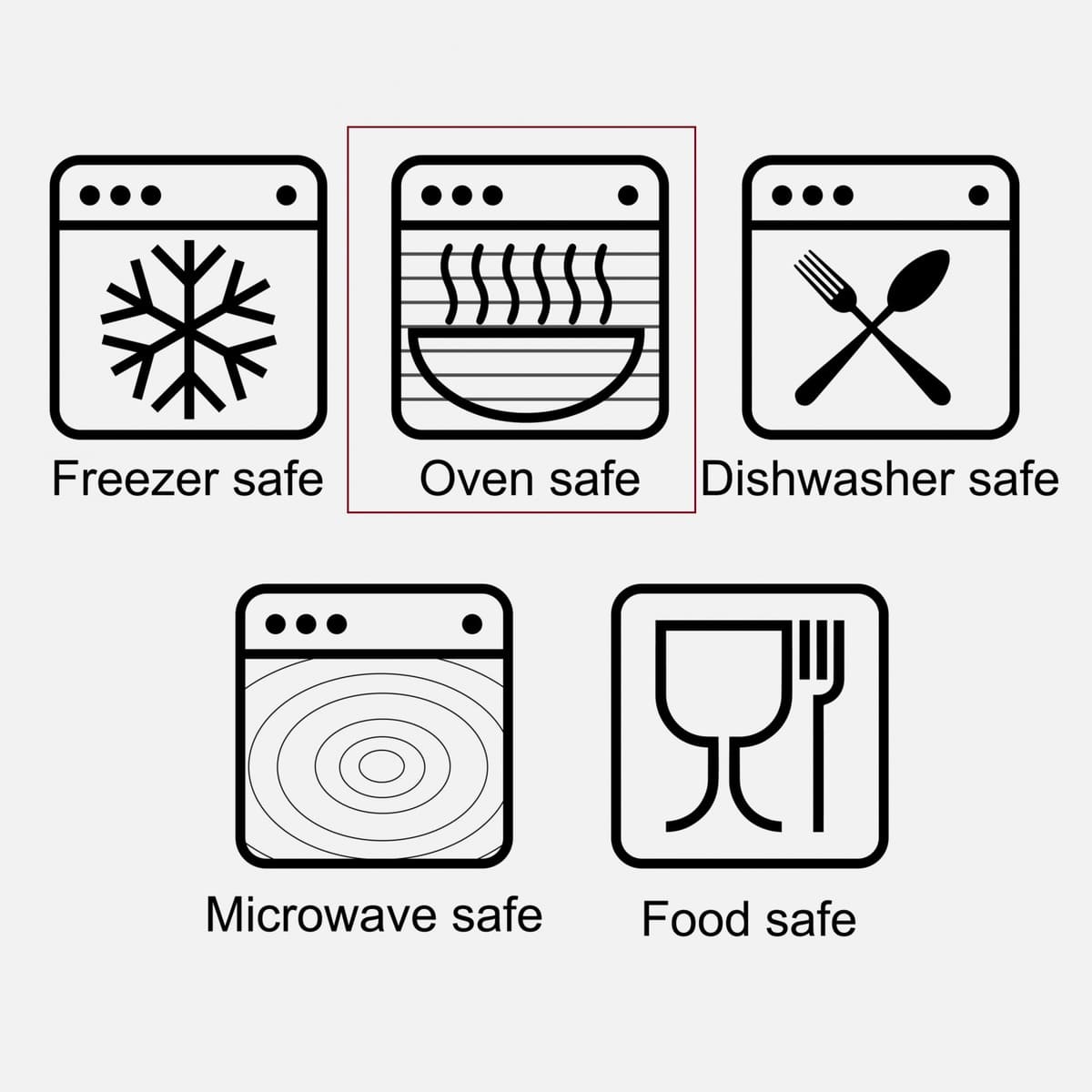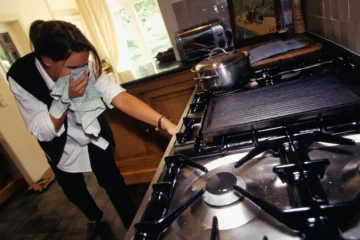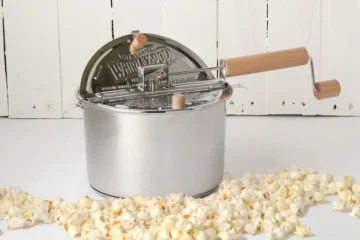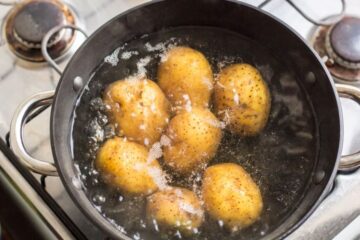Have you ever wondered what does the oven safe symbol mean? It’s a common symbol on the bottom of pots, pans, and dishes, but many of us are left scratching our heads about its significance. As it turns out, the oven-safe symbol is much more important than you may have realized, and its meaning can vary depending on the type of cookware you’re using.
In this blog post, we will uncover the hidden discovery behind the oven-safe symbol and provide you with all the information you need to ensure your cookware is safe to use in the oven. We’ll also explore the different types of oven safe symbols and what they indicate and provide tips for safely using your cookware in the oven.
It doesn’t matter if you’re an experienced cook or just getting started, understanding the oven-safe symbol is crucial for cooking delicious meals safely and efficiently. So let’s dive in and discover the mystery behind this essential kitchen symbol!
What Is The Oven Safe Symbol?
The oven safe symbol is a small icon typically found on the bottom of cookware or bakeware, indicating that the item is safe to use in the oven. The symbol often consists of a square with additional details, such as a temperature range or an image of an oven.
What Does The Oven Safe Symbol Mean?
Oven Safe Symbol Meaning:
The oven safe symbol means that the cookware or bakeware is safe to use in the oven without causing damage or posing a safety hazard. It indicates that the cookware can withstand high temperatures typically used in baking, roasting, and broiling.
Different cookware may have different temperature limits, so checking the manufacturer’s instructions or the symbol for specific temperature ranges is essential. Some cookware may be labeled as “oven safe up to 350°F,” while others may be labeled as “oven safe up to 500°F.”
It’s also important to note that some cookware may have limitations on how long it can be used in the oven or at specific temperatures. Again, referring to the manufacturer’s instructions or the oven safe symbol for specific details is essential.
What Does The Oven Safe Symbol Look Like?
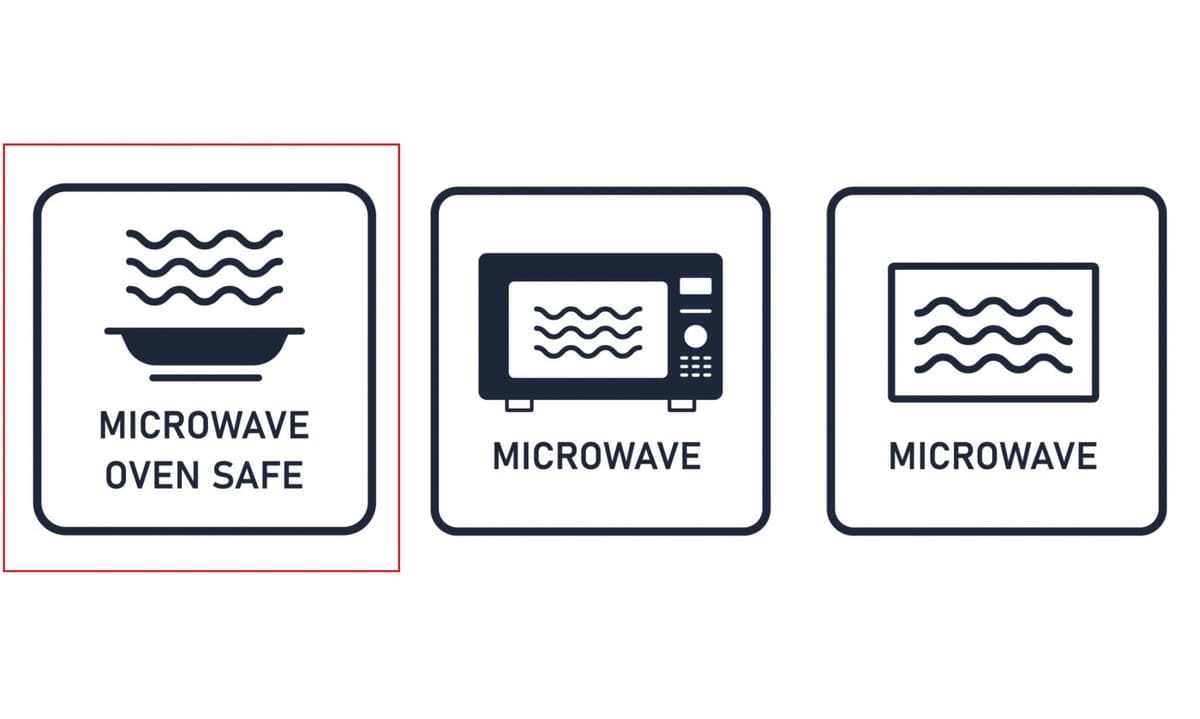
The oven safe symbol can vary depending on the manufacturer or country. Still, it typically features a small icon or image indicating the cookware is safe in the oven. Here are a few common variations of the oven safe symbol:
- A square with three horizontal lines inside indicates heat radiating from an oven’s bottom.
- A square with the word “oven” inside or next to it.
- A square with an oven rack inside, indicating that the cookware can be used on that rack.
- A square with a temperature limit or range inside or next to it indicates the highest temperature the cookware can withstand in the oven.
In addition to these symbols, some cookware manufacturers may include additional instructions or warnings, such as “do not use on stovetop” or “preheat the oven before use.” Reading and following these instructions carefully ensures the cookware is used safely and effectively in the oven.
How To Know If Something Is Oven Safe?
Knowing whether something is oven safe ensures you can cook or reheat food safely without damaging the cookware. Here are some ways to determine if something is oven safe:
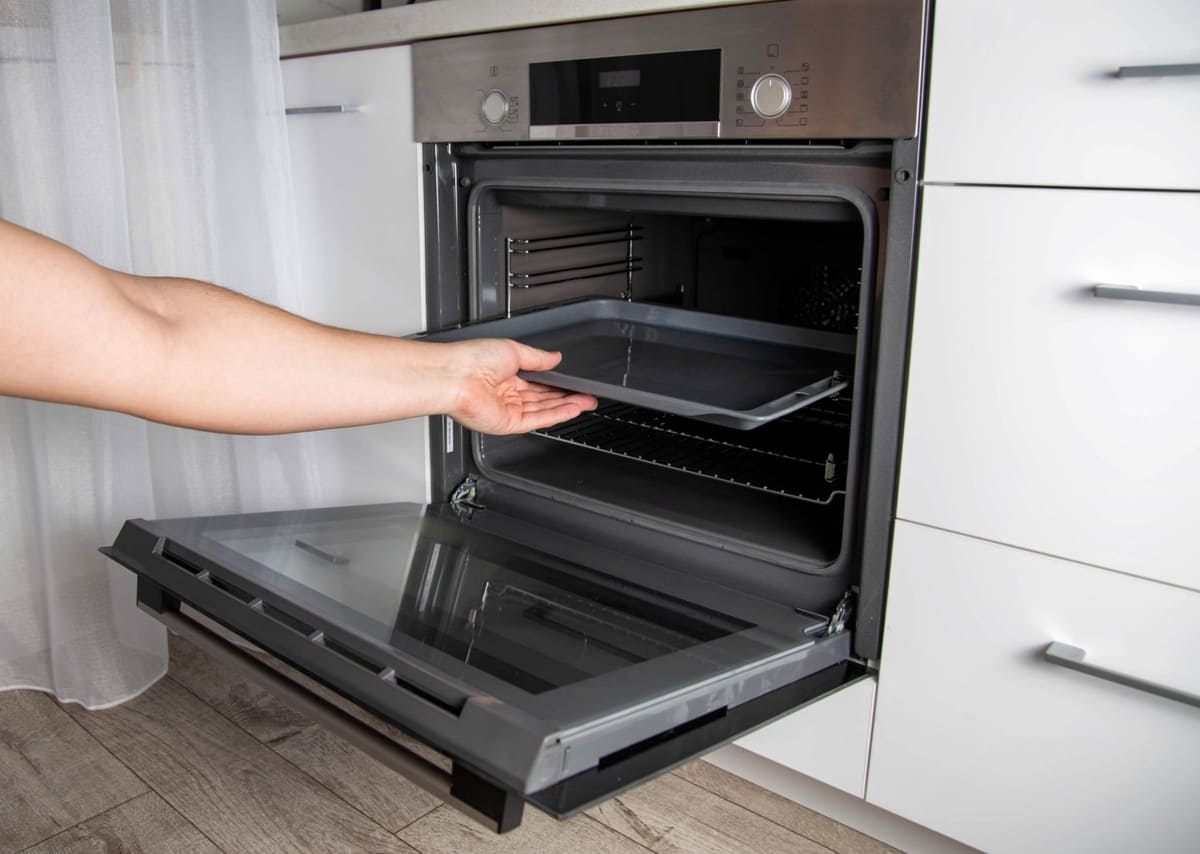
1. Check the manufacturer’s instructions
Most cookware comes with manufacturer’s instructions that state the maximum temperature and cooking duration the product can withstand. You can check the product’s manual or packaging for this information.
2. Look for symbols
Some cookware comes with symbols that indicate its oven-safe temperature limits. An “oven-safe” symbol is often shown as a small oven icon with a maximum temperature limit of degrees Fahrenheit or Celsius.
3. Consider the material
Different materials can withstand different oven temperatures. For example, glass and ceramic are generally oven safe. Still, metal cookware with a non-stick coating that can break down at high temperatures may be unsafe.
4. Check for visible damage
If the cookware is cracked, chipped, or warped, it is unsafe for oven use. Damaged cookware can shatter or break at high temperatures, causing injury and damaging your oven.
5. Conduct a test
You can conduct a simple test if you are unsure whether a particular item is oven safe. Place the cookware in a preheated oven at 350 degrees Fahrenheit for 30 minutes. If it remains unchanged, it is probably oven safe.
Materials that are Oven Safe
- Stainless Steel: This material is durable, non-reactive, and can withstand high temperatures.
- Cast Iron: Cast iron is a popular choice for oven-safe cookware because it can withstand high temperatures and distributes heat evenly.
- Ceramic: Ceramic cookware is often oven-safe, but checking the manufacturer’s instructions is essential.
- Glass: Heat-resistant glass, such as borosilicate glass, is often used for oven-safe cookware.
- Copper: Copper cookware can be oven-safe but should be lined with a non-reactive material like stainless steel or tin.
Benefits of Using Oven-Safe Cookware
Using oven-safe cookware has several benefits, making it a valuable addition to any kitchen. One of the main advantages is that it allows for greater versatility when cooking, as you can quickly transfer dishes from the stovetop to the oven. This is particularly useful for recipes that require both cooking methods, such as searing meat on the stovetop and finishing it in the oven.
Another benefit of oven-safe cookware is that it allows even heating and cooking. Materials like cast iron and stainless steel distribute heat evenly, ensuring food is cooked thoroughly and consistently. This can help prevent overcooking or undercooking, resulting in more delicious and perfectly cooked meals.
Oven-safe cookware is also generally more durable than other types of cookware. It is designed to withstand high temperatures and can be used for various cooking methods. It is less likely to warp or become damaged over time, making it a wise investment for any home cook.
Finally, oven-safe cookware can simplify cleanup, as many materials can be placed directly in the dishwasher after use. This eliminates the need for scrubbing or hand-washing, saving time and effort in the kitchen.
How to Properly Use Oven-Safe Cookware?
To properly use oven-safe cookware, first ensure that the cookware you are using is oven-safe. Look for the manufacturer’s label or instructions to determine the temperature limits and other specific oven use guidelines. Preheat your oven to the desired temperature before placing the cookware inside. Use oven mitts or potholders to handle the cookware, as it will be hot.
Avoid sudden temperature changes, such as placing a hot pan in cold water, as this can cause warping or cracking. Follow the recipe or cooking instructions carefully and check on the food regularly to avoid overcooking or burning. When removing the cookware from the oven, place it on a heat-resistant surface and allow it to cool before handling or cleaning it.
Common Mistakes to Avoid
There are several common mistakes to avoid when using oven-safe cookware.
One of the biggest mistakes is using cookware that is not oven-safe. Always check the manufacturer’s instructions before using any cookware in the oven to avoid damaging the cookware or causing a safety hazard.
Another mistake is not preheating the oven before placing the cookware inside. Preheating allows the oven and the cookware to reach the desired temperature evenly. Using metal utensils or abrasive scrubbers on non-stick oven-safe cookware can also cause damage.
Also, avoid using cooking sprays on non-stick cookware, which can cause difficult-to-clean buildup. Finally, be careful to keep the cookware manageable, as this can affect the cooking time and temperature and lead to unevenly cooked food.
Can I Put Any Pan In The Oven?
No, not all pans can be put in the oven. It is essential to check the manufacturer’s instructions or label to determine if a pan is oven-safe before using it in the oven. Some pans may have plastic handles or coatings that can melt or release harmful fumes when exposed to high heat, so avoiding using these pans in the oven is essential. Also, some pans may not withstand the oven’s high temperatures, which can cause warping, cracking, or even a fire hazard.
How To Tell If A Pan Is Oven Safe?
Oven Safe Pan Symbol:
You should check the manufacturer’s instructions or label to tell if a pan is oven-safe. Look for any information related to the temperature limits and specific guidelines for use in the oven. If the pan has no label or instructions, you can check its material to determine if it is oven-safe.
Generally, pans made of metal, including stainless steel, aluminum, and cast iron, are safe in the oven. However, pans with non-stick coatings or plastic handles may be unsafe for oven use. Additionally, pans with decorative elements, such as paint or decals, may be unsafe for high-temperature exposure. It is always better to be cautious and double-check before using a pan in the oven. An oven-safe pan can damage the pan or cause a safety hazard.
How Can You Tell If A Bowl Is Oven Safe?
There are a few ways to determine if a bowl is oven safe:
- Look for markings: Many manufacturers will label their products with information about their safe use. Check the bottom or sides of the bowl for any markings that indicate it is oven safe.
- Check the material: Bowls made from glass, ceramic, and certain metals like stainless steel are often oven safe. However, it’s essential to check the manufacturer’s instructions to confirm.
- Look for temperature limitations: Even if a bowl is oven safe, it may have limitations on the maximum temperature it can withstand. Check the manufacturer’s instructions for any temperature limitations.
- Use the water test: Fill the bowl with water and place it in the oven at a low temperature. If the bowl cracks or breaks, it is not oven safe.
How To Tell If A Pot Is Oven Safe?
In order to tell if a pot is oven safe, look for markings on the pot itself or on the packaging that indicates it is safe to use in the oven. These markings may include statements such as “oven safe,” “safe for use in ovens,” or a symbol that looks like an oven with a temperature range.
If no markings indicate the pot is oven safe, it is best to err on the side of caution and assume it is not safe for use in the oven. Using a pot that is not oven safe can damage it or even pose a safety risk if it breaks or cracks in the oven.
How To Tell If Pyrex Is Oven Safe?
Pyrex is a brand of borosilicate glass cookware that has been popular for over 100 years due to its durability and versatility. The good news is that most Pyrex glassware is oven safe, but you should keep a few things in mind to ensure you use it safely.
Firstly, check the bottom of the Pyrex dish for any labeling or symbols that indicate whether it is safe for oven use. This can include a temperature range or an oven-safe icon.
Secondly, it’s important to note that Pyrex dishes can break or shatter if exposed to sudden changes in temperature, such as going from a hot oven to a cold countertop or sink. Always place your Pyrex dish on a hot pad or trivet before setting it on a cold surface to prevent this.
Lastly, avoid using Pyrex dishes on the stovetop, as they are not designed to withstand direct heat from burners.
What Temp Is Oven Safe?
Most ovens are safe to use at 325°F (162°C). This is a common temperature used for baking and roasting various types of food, such as cakes, casseroles, and meats. However, it’s important to note that the specific temperature range that your oven is safe to use may vary depending on the make and model of your oven.
Does All Cooking Types Mean Oven Safe?
No, all cooking types do not necessarily mean oven-safe. While many cooking methods may involve an oven, not all cookware or cooking utensils suit an oven.
For example, some types of cookware, such as those made of certain plastic, may not be safe for an oven because they can melt or release harmful chemicals when exposed to high temperatures. Similarly, some types of cookware may have non-stick coatings that can be damaged by high heat or release toxic fumes if heated above a specific temperature.
It’s important always to check the manufacturer’s instructions for your cookware and utensils to ensure that they are safe for use in the oven before attempting to use them in this way. If you’re unsure, it’s best to err on the side of caution and avoid using them in the oven to prevent damage to your cookware, your food, or your health.
Is 450 Degrees Oven-Safe?
It depends on the object’s material you are trying to put in the oven.
Most ovens are designed to handle temperatures up to 500 degrees Fahrenheit (260 degrees Celsius) without issues. Still, not all materials can withstand such high temperatures.
For example, some plastics and low-quality ceramics may only be able to handle temperatures above 450 degrees Fahrenheit (232 degrees Celsius) with melting or cracking.
What Does Oven-Safe To 450 Mean?
When a product is labeled as “oven-safe to 450 degrees,” it can be safely used in the oven at temperatures up to 450 degrees Fahrenheit (232 degrees Celsius) without melting, warping, or otherwise becoming damaged.
It is important to note that different materials may have different oven-safe temperatures. For example, some types of glass bakeware may be oven-safe up to 500 degrees Fahrenheit (260 degrees Celsius). In comparison, certain types of plastic containers may only be safe up to 350 degrees Fahrenheit (177 degrees Celsius).
Overall Thoughts On Oven Safe Symbol
So, the oven safe symbol is crucial to ensure our safety when cooking with ovenware. Knowing what the symbol means and how to interpret it is essential in avoiding accidents in the kitchen. While the symbol may be hidden or not readily visible on some products, it’s crucial to always check the manufacturer’s instructions and guidelines before using any ovenware.
Furthermore, taking care of your ovenware and avoiding sudden temperature changes will help extend its lifespan and keep you safe in the kitchen. By following these simple steps, you can cook your favorite dishes with confidence and ease, knowing that your ovenware is safe and ready to use.
